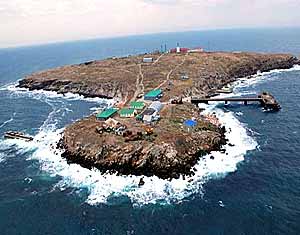26.02.2009
February 13, 2009 (the date of publication in Russian)
Alexei Chichkin
"SERPENT'S" MOVE
Romania's victory over Ukraine in the International Court of Justice might stand on the way of building South Stream
 Seems like a new complex combination aimed against the building of South Stream pipeline under the Black Sea is developing. The International Court of Justice passed a judgment, unprecedented for the former-Soviet territories since the USSR collapsed. And in particular: Zmeinyi (Serpents') island, which is situated in the north-west of the Black Sea can't be considered a part of Ukrainian coastal line for distinguishing the middle line while delimiting continental shelf and exclusive economic zone(see here and here). What's typical, it happened few days after Alexander Medvedev, a Vice-Chairman of Gazprom, had made a statement about 30% increasing of South Stream projected capacity to 53-55 billion cubic meters per year.
Seems like a new complex combination aimed against the building of South Stream pipeline under the Black Sea is developing. The International Court of Justice passed a judgment, unprecedented for the former-Soviet territories since the USSR collapsed. And in particular: Zmeinyi (Serpents') island, which is situated in the north-west of the Black Sea can't be considered a part of Ukrainian coastal line for distinguishing the middle line while delimiting continental shelf and exclusive economic zone(see here and here). What's typical, it happened few days after Alexander Medvedev, a Vice-Chairman of Gazprom, had made a statement about 30% increasing of South Stream projected capacity to 53-55 billion cubic meters per year.
The mentioned decision made by the Court means 65% of adjacent water area with all its resources is now de jure considered to belong to Romania. Meanwhile this region is rich in large oil- and especially gas resources.
The case about the belonging of the very territories had been examined by the International Court of Justice since 2004 on Romania's initiative. The country disputes Ukrainian belonging of the island itself (actually, it was included in the Romanian Bessarabia in 1918-1940 and 1942-1945). Ukraine counterclaimed a memorandum about Zmeinyi island and adjacent waters, but these arguments were neglected.
As a consequence, Romania, which is offended by South Stream omitting it and because of this lobbying for unprofitable for the Russian Federation Nabucco gas pipeline (Central Asia – Caspian Sea – Azerbaijan – Georgia – Turkey – Balkans – Central Europe), becomes the owner of huge gas resources. Romanian geologists' drilling in this part of the Black Sea "moves" to the South –perpendicularly to the Black Sea South Stream line. It's quite obvious, that in case of operational drilling the building of gas pipeline in the marked line might slow down. Moreover, the gas belt stretches into Bulgarian sector of the Black Sea to the south. And there, according to the analytical Mineral center (2008) some developments are also held with the help of British companies (the volume of reserves, found there is while estimated as 2 billion cubic meters).
The Ukrainian Chernomorneftegaz had found large commercial reserves of oil and gas 40 km to the south from Zmeinyi island, which means in the direction to Bulgaria, already in 2000-2002. This data confirmed geological explorations already made in 1950s and 1970s. Moreover, the mentioned resources are located on a depth, which is really comfortable for commercial production – only 2.2 – 2.5 km under. Predicted volumes of these resources are 10 million tonnes of oil and more than 12 billion cubic meters of gas. And according to modern Romanian ratings, commercial reserves of oil and gas to the south of Zmeinyi island are, in accordance, 15-18 million tonnes and more than 20 billion cubic meters. And more, these gas "storehouses" don't only reach Romanian-Bulgarian sea border, but cross it also. It means they exactly connect with the line of South Stream. And the profitability of commercial production of the raw materials if to transfer it by pipelines might reach 49% for Romanian companies. And this rate is actually the highest all over the Europe, including former Soviet territories. Romania has already begun developing oil and gas wells to the west from Zmeinyi, where the pipelines to Constanta port are built.
Florin Muntean, the head of Romanian TRANSGAZ S.A. gas company, supposed that "in future Russia won't be able to provide the increased European demand for gas. But… Romania has an advantage over its neighbours, as it provides 60% of its own use by its own production. There is a project of consolidation of Romanian and Hungarian gas systems…" We will add that from the beginning of 1950s and to the first half of 1980s Romania supplied at least 15% of Hungary's demand for gas, pumping it from former Hungarian Transylvania (later the supply stopped for political reasons).
According to the latest Romanian data, the proved reserves of natural gas in the country are more than 200 billion cubic meters, including about 100 billion cubic meters located on the Black Sea shelf and in Danube (Donau or Dunaj) delta. So, it's quite possible that Romanian Danubian-Black Sea gas may join Nabucco. But on the other hand, together with gas-development in Bulgarian sector of the Black Sea, it can directly or indirectly hinder the creation of South Stream.
Number of shows: 2166
 ENG
ENG 

 ENG
ENG 
